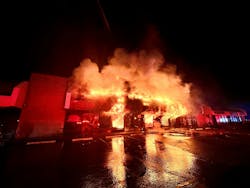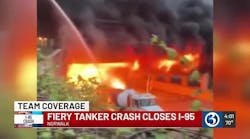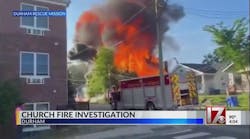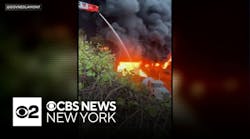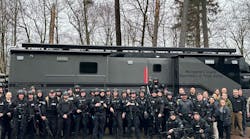When I attended a recent fire service conference, I had the pleasure of spending time with a statesman of the American fire service, a legend who has dedicated himself to educating the fire service on risk. We discussed one of his favorite topics: the misdirected glorification of firefighter fatalities. What he so passionately believes, ultimately, boils down to culture and risk management, two buzzwords that are overused and two facets of our profession that often are poorly managed.
Risk is a common topic in incident management and fire service organizations. Many of us heard the saying, “Risk a little to save a little, risk a lot to save a lot.” What exactly is “a little”? More importantly, what is “a lot”? How do we make risk-management decisions that directly relate to our life and death, based on something that we don’t measure?
Risk/control imbalance
Most fire officers are comfortable with the following scenario: You arrive at a nighttime fire in a single-family dwelling and are told by family that a child is trapped in the house and that the fire currently is isolated to the master bedroom. You decide to immediately conduct a rescue. This probably is a scenario in which most officers are comfortable taking a large amount of mitigated risk to achieve the objective. Conversely, I believe that any fire officer would agree that it isn’t worth deploying the same amount of risk at a fully involved, abandoned barn. However, those are bookends of risk decisions, and it rarely is that simple.
A fundamental of risk management in the fire service is identifying any risk/control imbalance and swiftly making the appropriate corrections to bring the matter back into balance. Whenever risk and controls don’t match up, we must make the necessary adjustments to regain that equilibrium. When a crew enters a structure to investigate a ringing alarm and, all of a sudden, the members encounter an immediately dangerous to life and health scenario, they probably will don SCBA, back out and request additional resources; within seconds, the risk/control ratio starts to return to balance.
At a structure fire, the decision to undertake aggressive interior operations represents one of the most critical decisions for a company officer/incident commander. That decision-maker directly makes a choice that can have fatal consequences. Using the primary objectives of mitigating threats to life and property via incident stabilization, the primary questions that must be asked to assess and analyze the risk are:
- Is there a savable victim to rescue?
- Can meaningful preservation of property be provided?
- If the answer to either of the first two questions is in the affirmative, is there a safe way to manage the risk to accomplish these goals?
For the property part of the equation, consider this: In numerous states, a structure is deemed unsalvageable by insurers once it’s more than approximately 30 percent damaged in a fire. Although that might not take into consideration contents and personal keepsakes, the structure itself has a low threshold of damage before it becomes economically beneficial to raze it and rebuild versus attempting to repair the damage. That doesn’t mean that 30 percent involvement is a hard line for whether firefighters make an interior attack, but it does mean that the reward for that risk starts to look a lot less worthwhile from a firefighter safety standpoint. Of course, there might be extenuating circumstances, such as exposures or special hazards, and those are all necessary components of the decision-making process.
Saving victims
We are fortunate to have detailed statistics from the Firefighter Rescue Survey, breaking down 3,507 rescues (as of March 29, 2024) and their respective survival rates. Regardless of our assumptions, there was a victim only 3 percent of the time when arriving companies were given a report that there was no one inside. Further, out of 3,507 rescues, when crews arrived at exterior structural involvement of at least 50 percent and were told that no victims were inside, there were only nine total saves (along with eight body recoveries).
During roughly the same time frame, 58 firefighters died at structure fires while search/rescue or fire attack operations were conducted; 57 percent of those deaths were a result of structural collapse or getting trapped. Although these aren’t apples-to-apples with the rescue statistics, it isn’t difficult to see that it doesn’t add up to a balanced risk profile.
As is true with most things in life, this boils down to the human factor. At the end of the day, no position has a greater role in the safety of a firefighter than the company officer. The buck stops with the company officer who leads a crew inside of a building or onto a roof. Twelve percent of all rescues in the survey were conducted when structural involvement exceeded 50 percent on arrival, even though the chance of saving the property is next to nothing, and survivability is less than half versus when crews arrive to smoke only.
RISK checklist
Although the fire service focuses heavily on the incident command system (ICS) and the technical skills that are required for the fireground, how much time is spent with company officers to conduct formal risk-analysis training on structural fireground decisions?
Wildland firefighting, with its own unique set of firefighter risks, has created a foundation of risk management and tactical engagement decision-making processes. There are a variety of platforms that are taught across ranks in wildland firefighting, including:
- 10 Standard Firefighting Orders
- 18 Watchout Situations
- PACE (primary, alternate, contingency, emergency)
- DRAW-D (defend, reinforce, advance, withdraw, delay)
These create a thought process for the officer at a wildland incident to have a rapid informal system for doing a quick assessment of risk before engagement.
These same types of methods can be applied to structural firefighting. Although some departments already emphasize risk analysis and tactical decision-making in structural firefighting, there is a wide spectrum of its application across the fire service. (See “Fire Studies: Applying Wildland Fire Safety to Structural Fires”.) In addition to ICS training and hands-on tactics, departments can train officers to take a systematic approach to evaluating tactical engagement at structure fires. A basic four-step checklist to consider to assess risk before engagement at a structure fire (RISK) includes:
- Rescue: Does the report indicate that nobody is inside?
- Involvement: Is the building approximately more than one-quarter involved with fire?
- Special considerations (fire in basement; hoarder situation; structural concern regarding collapse or unknown burn time; weather issues, such as wind)?
- Known delays (for water supply, additional fire units)?
Decisions under stress
Managing risk on the fireground isn’t an exact science, but the risk profile of an incident that includes three of the above categories is quite different than one that has none of them.
Scenario 1: You are the first-arriving engine company to a single-family residence in the middle of the day. You encounter a large, single-story house that appears to be about one-third involved, with heavy fire on one side of the structure. No vehicles are in the driveway. A neighbor tells you that the family is on vacation. Your next-in engine and truck companies are 8–10 minutes out.
Utilizing the four-step RISK checklist, three of the four categories apply. You decide that the risk profile is too high, and you must take steps to address it and to protect crew safety. You decide to secure a water supply and initiate a transitional attack until the risk profile changes by knocking down a large portion of the fire from the exterior and waiting for additional companies to arrive.
Scenario 2: You arrive at a closed business in a strip mall in the middle of the night and see very light smoke coming from under the door of the business. A hydrant is out front. Your next-in companies are close. It’s unknown whether anyone is inside.
Using the RISK checklist, none of the four categories applies. You decide that the risk profile is acceptable to proceed. You prepare to gain access and conduct interior operations once a RIC is in place and a 360 size-up can be completed.
Although some of these concepts might seem intuitive, having a predefined system in place to evaluate risk helps to prevent errors in decisions that are made during high-stress events. If you and your agency have an agreed-upon risk-management process for operating at structure fires, these decisions become much easier to make under stress.
A circumstance of a well-involved structure, particularly with on-scene reports of no victims inside and a water supply issue, probably should fall squarely into the “risk a little to save a little” side of decision-making. That doesn’t mean that you risk nothing. It means that you take mitigated risk and live to fight another fire.
